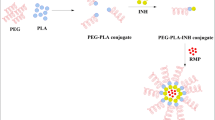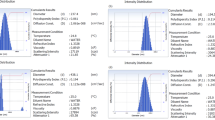Abstract
Purpose
Tuberculosis (TB) chemotherapy witnesses some major challenges such as poor water-solubility and bioavailability of drugs that frequently delay the treatment. In the present study, an attempt to enhance the aqueous solubility of rifampicin (RMP) was made via co-polymeric nanoparticles approach. HPMA (N-2-hydroxypropylmethacrylamide)-PLGA based polymeric nanoparticulate system were prepared and evaluated against Mycobacterium tuberculosis (MTB) for sustained release and bioavailability of RMP to achieve better delivery.
Methodology
HPMA-PLGA nanoparticles (HP-NPs) were prepared by modified nanoprecipitation technique, RMP was loaded in the prepared NPs. Characterization for particle size, zeta potential, and drug-loading capacity was performed. Release was studied using membrane dialysis method.
Results
The average particles size, zeta potential, polydispersity index of RMP loaded HPMA-PLGA-NPs (HPR-NPs) were 260.3 ± 2.21 nm, −6.63 ± 1.28 mV, and 0.303 ± 0.22, respectively. TEM images showed spherical shaped NPs with uniform distribution without any cluster formation. Entrapment efficiency and drug loading efficiency of HPR-NPs were found to be 76.25 ± 1.28%, and 26.19 ± 2.24%, respectively. Kinetic models of drug release including Higuchi and Korsmeyer-peppas demonstrated sustained release pattern. Interaction studies with human RBCs confirmed that RMP loaded HP-NPs are less toxic in this model than pure RMP with (p < 0.05).
Conclusions
The pathogen inhibition studies revealed that developed HPR-NPs were approximately four times more effective with (p < 0.05) than pure drug against sensitive Mycobacterium tuberculosis (MTB) stain. It may be concluded that HPR-NPs holds promising potential for increasing solubility and bioavailability of RMP.








Similar content being viewed by others
Abbreviations
- ACN:
-
Acetonitrile
- ETB:
-
Ethambutol
- HPMA:
-
N-2-hydroxypropylmethacrylamide co-polymer
- HP-NPs:
-
HPMA-PLGA nanoparticles
- HPR-NPs:
-
Rifampicin loaded HPMA-PLGA nanoparticles
- INH:
-
Isoniazid
- MABA:
-
Microplate Alamar Blue Assay
- MTB:
-
Mycobacterium tuberculosis
- MIC:
-
Minimum inhibitory concentration
- NPs:
-
Nanoparticles
- PLGA:
-
Poly-lactic-co-glycolic acid
- PNPs:
-
Polymeric Nanoparticles
- PPB:
-
Plasma protein binding
- PYZ:
-
Pyrazinamide
- RMP:
-
Rifampicin
- STP:
-
Streptomycin
- TB:
-
Tuberculosis
- TEM:
-
Transmission electron microscopy
- WHO:
-
World Health Organization
References
World Health Organization Treatment of tuberculosis: guidelines for national programmes Geneva: WHO Global Tuberculosis Report 2017.
Sosnik A, Carcaboso R, Glisoni M, Chiappetta MD. New old challenges in tuberculosis: potentially effective nanotechnologies in drug delivery. Adv Drug Deliv Rev. 2010;62:547–59.
World Health Organization Communicable Diseases Cluster: Fixed-dose combination tablets for the treatment of tuberculosis 1999.
Mitchison DA. Role of individual drug in chemotherapy of tuberculosis. Int J Tuber Lung Dis. 2000;4:790–800.
Joshi JM. Tuberculosis chemotherapy in the 21 century: Back to the basics. Lung India. 2011;28:193–200.
Zhang Y, Yew WW. Mechanisms of drug resistance in Mycobacterium tuberculosis. Int J Tuber Lung Dis. 2009;13:1320–30.
Ain QU, Sharma S, Khuller GK, Garg SK. Alginate-based oral drug delivery system for tuberculosis: pharmacokinetic and therapeutic effects. J Antimicrob Chemother. 2003;51:931–8.
Labana S, Pandey R, Sharma S, Khuller GK. Chemotherapeutic activity against murine tuberculosis of once weekly administered drugs (INH and RMP) encapsulated in liposomes. Int J Antimicrob Agents. 2002;20:301–4.
Emerich DF, Thanos CG. Targeted nanoparticle-based drug delivery and diagnosis. J Drug Target. 2007;15:163–83.
Desjardins M, Griffiths G. Phagocytosis: latex leads the way. Curr Opin Cell Biol. 2003;15:498–503.
Pandey R, Khuller GK. Nanotechnology based drug delivery system(s) for the management of tuberculosis. Indian J Exp Biol. 2006;44:357–66.
Pandey R, Khuller GK. Chemotherapeutic potential of alginate-chitosan microspheres as anti-tubercular drug carriers. J Antimicrob Chemother. 2004;53:635–40.
Danhier F, Ansorena E, Silva JM, Coco R, Breton AL, Preat V. PLGA-based nanoparticles: an overview of biomedical applications. J Control Release. 2012;161:505–22.
Kopecek J, Kopeckova P, Minko T, Lu Z. HPMA copolymer–anticancer drug conjugates: design activity and mechanism of action. Eur J Pharm Biopharm. 2000;50:61–81.
Duncan R. Designing polymer conjugates as lysosomotropic nanomedicines. Biochem Soc Trans. 2007;35:56–60.
Rihova B, Ulbrich K, Kopecek J, Mancal P. Immunogenicity of N-(2-hydroxypropyl)-methacrylamide copolymers-potential hapten or drug carriers. Folia Microbiol. 1983;28:217–27.
Ulbrich K, Subr V, Strohalm J, Plocova D, Jelinkova M, Rihova B. Polymeric drugs based on conjugates of synthetic and natural macromolecules synthesis and physico-chemical characterization. J Control Release. 2000;64:63–79.
Wang D, Kopeckova JP, Minko T, Nanayakkara V, Kopecek J. Synthesis of starlike N-(2-hydroxypropyl) methacrylamide copolymers: potential drug carriers. Biomacromolecules. 2000;1:313–9.
Dvorak M, Kopeckova P, Kopecek J. High-molecular weight HPMA copolymer–adriamycin conjugates. J Control Release. 1999;60:321–32.
Chytil P, Etrych T, Kriz J, Subr V, Ulbrich K. N-(2-Hydroxypropyl) methacrylamide-based polymer conjugates with pH-controlled activation of doxorubicin for cell-specific or passive tumour targeting synthesis by RAFT polymerisation and physicochemical characterization. Eur J Pharm Sci. 2010;41:473–82.
Chan JM, Zhang L, Yuet KP, Liao G, Rhee JW, Langer R, et al. PLGA–lecithin–PEG core–shell nanoparticles for controlled drug delivery. Biomaterials. 2009;30:1627–34.
Tomcin S, Kelsch A, Staff RH, Landfester K, Zentel R, Mailander V. HPMA-based block copolymers promote differential drug delivery kinetics for hydrophobic and amphiphilic molecules. Acta Biomater. 2015;35:12–22.
Vandervoort J, Ludwig A. Preparation and evaluation of drug-loaded gelatin nanoparticles for topical ophthalmic use. Eur J Pharm Biopharm. 2004;57:251–26.
Song H, Geng H, Ruan J, Wang K, Bao CN, Wang J, et al. Development of Polysorbate 80/phospholipid mixed micellar formation for docetaxel and assessment of its in vivo distribution in animal models. Nanoscale Res Lett. 2011;6:354.
Singhai AK, Jain S, Jain NK. Evaluation of an aqueous injection of Ketoprofen. Pharmaz. 1997;52:149–51.
Franzblau SG, Witzig RS, Mclaughlin JC, Torres P, Madico G, Hernandez A, et al. Rapid low-technology MIC determination with clinical Mycobacterium tuberculosis isolates by using the microplate Alamar blue assay. J Clin Microbiol. 1998:362–6.
Kalluru R, Fenaroli F, Westmoreland D, Ulanova L, Maleki A, Roos N, Madsen P, Koster G, Egge-Jacobsen W, Wilson S, Roberg-Larsen H, Khuller GK, Singh A, Nystrom B and Griffiths G. Poly(lactide-co-glycolide)-rifampicin nanoparticles efficiently clear Mycobacterium bovis BCG infection in macrophages and remain membrane-bound in phago-lysosomes. J Cell Sci. 2013;126:3034–54.
Kopecekj J, Copolymers KPHPMA. Origins early developments present and future. Adv Drug Deliv Rev. 2010;62:122–49.
Khan I, Gothwal A, Sharma AK, Qayumb A, Singh SK, Gupta U. Biodegradable nano-architectural PEGylated approach for the improved stability and anticancer efficacy of bendamustine. Int J Biol Macromol. 2016;92:1242–51.
Pelizza G, Nebuloni M, Ferrari P, Gallo GG. Polymorphism of rifampicin II. Farmaco. 1977;32:471–81.
Jindal KC, Chaudhary RS, Singla AK, Gangwal SS, Khanna S. Dissolution test methods for rifampicin-isoniazid fixed dose formulations. J. Pharm Biomed Anal. 1995;57:420–2.
Woo J, Cheung W, Chan R, Chan HS, Cheng A, Chan K. In vitro binding characterstics of isoniazid, rifampicin and pyrazinamide to whole plasma, albumin and α-1-acid glycoprotein. Clin Biochem. 1996;29:175–7.
Bergogne-Berezin E. Clinical role of protein binding of quinolones. Clin Pharmacokinet. 2002;41:741–50.
Wise R. Protein binding of beta-lactams: the effects on activity and pharmacology particularly tissue penetration II studies in man. J Antimicrob Chemother. 1983;12:105–18.
Costa P and Lobo JMS. Modeling and comparision of dissolution profiles. Eur J Pharm Sci 2001;13:123–33.
Nan A, Nanayakkara NP, Walker LA, Yardley V, Croft SL, Ghandehari H. N-(2-hydroxypropyl)methacrylamide (HPMA) copolymers for targeted delivery of 8-aminoquinoline antileishmanial drugs. J Control Release. 2001;77:233–43.
ACKNOWLEDGMENTS AND DISCLOSURES
The authors acknowledge the financial support from the Rajasthan Department of Science and Technlogy, Jaipur India and Department of Science and Technology, New Delhi, India through DST Start up Research Grant (Young Scientists) to Dr. Umesh Gupta. Authors would also like to acknowledge Indian Council of Medical Research (ICMR) for providing facilities at JALMA, Agra, India. The authors declare no competing financial interest.
Author information
Authors and Affiliations
Corresponding author
Additional information
Publisher’s Note
Springer Nature remains neutral with regard to jurisdictional claims in published maps and institutional affiliations.
Highlights
• HPMA (N-2-hydroxypropylmethacrylamide) co-polymer was synthesized and characterized.
• HPMA-PLGA NPs were allowed to self-assemble in order to remove acetonitrile, organic solvent for safety purposes.
• Solubility of RMP was increased 65 folds via HPMA-PLGA hydrophilic co-polymer.
• Overall efficacy of the prepared polymeric nanoparticles against the Mycobacterium tuberculosis was enhanced several folds over the naïve drug RMP.
Rights and permissions
About this article
Cite this article
Rani, S., Gothwal, A., Pandey, P.K. et al. HPMA-PLGA Based Nanoparticles for Effective In Vitro Delivery of Rifampicin. Pharm Res 36, 19 (2019). https://doi.org/10.1007/s11095-018-2543-x
Received:
Accepted:
Published:
DOI: https://doi.org/10.1007/s11095-018-2543-x




